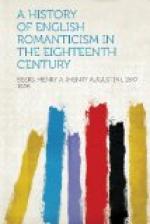[27] “Mr. Walpole and I have frequently wondered you should never mention a certain imitation of Spenser, published last year by a namesake of yours, with which we are all enraptured and enmarvelled.”—Letter form Gray to Richard West, Florence, July 16, 1740. There was no relationship between Gilbert West and Gray’s Eton friend, though it seems that the former was also an Etonian, and was afterwards at Oxford, “whence he was seduced to a more airy mode of life,” says Dr. Johnson, “by a commission in a troop of horse, procured him by his uncle.” Cambridge, however, was an acquaintance of Gray, Walpole, and Richard West, at Eton. Gray’s solitary sonnet was composed upon the death of Richard West in 1742; and it is worth noting that the introduction to Cambridge’s works are a number of sonnets by his friend Thomas Edwards, himself a Spenser lover, whose “sugared sonnets among his private friends” begin about 1750 and reach the number of fifty.
[28] “Life of West.”
[29] Lloyd, in “The Progress of Envy,” defines wimpled as “hung down”; and Akenside, in “The Virtuoso,” employs the ending en for the singular verb!
[30] Cf. “And as they looked,
they found their horror grew.”
—Shenstone.
“And still they gazed, and
still the wonder grew.”
—Goldsmith.
“The noises intermixed, which
thence resound,
Do learning’s little tenement betray.”
—Shenstone.
“There in his noisy mansion,
skilled to rule.” etc.
—Goldsmith.
[31] The poem was projected, and perhaps partly written, fourteen or fifteen years earlier.
[32] Cf. Tennyson’s “land in which it seemed always afternoon.”—The Lotus Eaters.
[33] Mickle’s authorship of this song has been disputed in favor of one Jean Adams, a poor Scotch school-mistress, whose poems were printed at Glasgow in 1734.
[34] Rev. John Sim’s “Life of Mickle” in “Mickle’s Poetical Works,” 1806, p. xi.
[35] Cf. Joseph Warton’s “Essay on Pope,” Vol. II. p. 35. “It has been fashionable of late to imitate Spenser; but the likeness of most of these copies hath consisted rather in using a few of his ancient expressions than in catching his real manner. Some, however, have been executed with happiness, and with attention to that simplicity, that tenderness of sentiment and those little touches of nature that constitute Spenser’s character. I have a peculiar pleasure in mentioning two of them, ’The Schoolmistress’ by Mr. Shenstone, and ‘The Education of Achilles’ by Mr. Bedingfield. And also, Dr. Beattie’s charming ‘Minstrel.’ To these must be added that exquisite piece of wild and romantic imagery, Thomson’s ‘Castle of Indolence.’”
[36] Byron, to be sure, began his first canto with conscious Spenserian. He called his poem a “romaunt,” and his valet, poor Fletcher, a “stanch yeoman,” and peppered his stanzas thinly with sooths and wights and_ whiloms_, but he gave over this affectation in the later cantos and made no further excursions into the Middle Ages.




